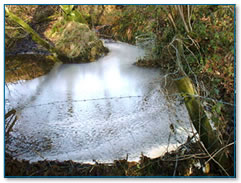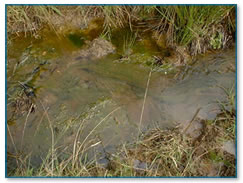water
and pollution pathways on a farm
 |
R. Lynher after
heavy rainfall Winter 2001 |
Rivers often have quite a few
pollutants in them that are there throughout the year. Sometimes
the pollution levels are higher than they should be by law. Pollutants
like sheep dip, slurry (mixture of dung and urine), soil, sand and
nutrients can get into a river in many different places along its
course. Pollutants can be a threat to the plants and animals that
live in, and rely upon, the river to survive
 |
Septic tank effluent |
It is really difficult to find out where pollutants are entering
a river. Showing landowners and farmers better ways of managing
land to benefit river wildlife and also save money is a good way
to help reduce pollution problems.
 |
Nutrient enrichment
in stream |
Slurry, soil and nutrients are all being wasted if they are washed
away in a river instead of being used on the land. This waste is
costing the farmer or landowner unnecessary money. Better management
of the land would save that money and help reduce the amount of
pollutants going into a river, this would also benefit wildlife.
|
Pollution sources
on a farm |
Exercise
Have a look at the ‘Water-use and
Pollution Pathways on a Farm’ sheet (W08b)
and see if you can workout where pollution might come from on a
farm.
|

